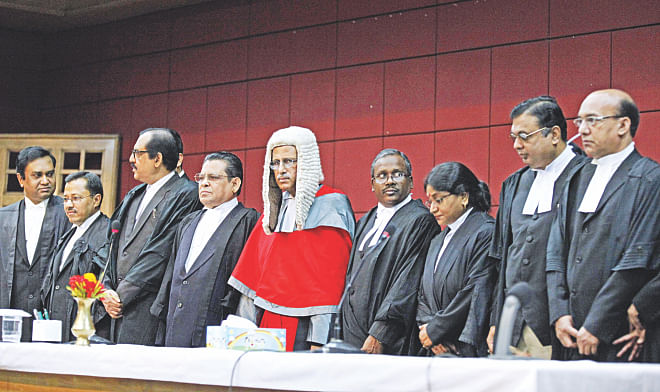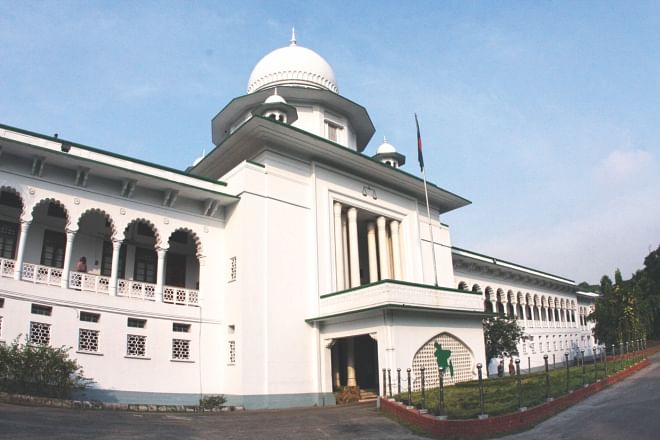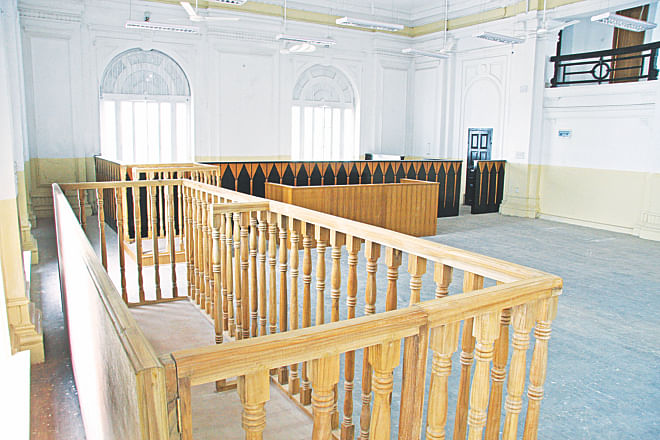Independence of the judiciary- the Masdar case

The Constitution of Bangladesh provides for an impartial and independent judiciary as one of its cornerstones and guardian. In reality though, the judiciary has been subservient to the all-powerful executive government since independence in 1971. Various governments made rhetorical promises to separate the judiciary from the executive only to appease popular demand for an independent judiciary. The domineering culture of executive autocracy over the constitutional imperative of the separation of power militated against the creation of an independent judiciary. This situation led Masdar Hossain, a lower court judge, to lodge a writ petition with the Supreme Court (SC) seeking an order for the separation of the judiciary from the executive as required in Article 22 of the Constitution.
The High Court Division (HCD) in May 1999 issued a directive to the government to separate the judiciary, both higher and lower, from the executive within eight weeks. This ruling prevailed on appeal in November 2000 and reaffirmed in the revision case in June 2001 in the Appellate Division (AD). The SC ruling worked out 12 directives for the government to implement the separation without any constitutional amendment, which went unheeded. Despite Articles 102 and 112 of the Constitution making all SC rulings binding for all citizens and authorities, the then government sought 26 extensions of time to implement the ruling and eventually left the office in October 2006 without separating the judiciary. The interim caretaker government that assumed office after October 2006 declared the separation in January 2007 and enacted four sets of rules to effect this separation. These rules, implemented by 1 July 2007, rendered the SC independent and brought the magistrates exercising judicial functions under the control of the SC, free of executive influence. This reform is yet to be implemented in the lower judiciary, which remains largely under the control of the executive.

In a hierarchical judiciary, the higher courts usually control subordinate courts to avoid deviations from the higher standard of judicial behaviour thus preventing damage to public confidence in the judiciary (Hussainara Khatoon v State of Bihar (1979) Cr L J 1045). The Constitution, in a number of provisions, warrants the separation of the judiciary from the executive as an overriding goal to ensure judicial independence in a functional sense. It contains explicit provisions for the independence of the lower judiciary. The HCD is authorised to administer, control, and supervise all subordinate courts (Art. 109). Articles 115 and 116 mandate the President to establish subordinate courts and appoint their judges and magistrates in consultation with the SC and pursuant to appropriate rules. Article 116A affords independent competence to all subordinate court judges in the exercise of their judicial functions. All these constitutional provisions purport to establish an orderly system of judicial hierarchy in which subordinate courts remain accountable to the SC and not to the executive.
The lower judiciary has an unequivocal mandate for its independence under Articles 109, 115, 116 and116A of the Constitution. Yet the President appointed subordinate court judges and magistrates through the Law and/or Home Ministry without adhering to the constitutional safeguard of consultation with the SC. The executive asserts absolute control over the lower judiciary, especially the magistracy, which enjoys little independence in performing judicial functions. The magistrates are an integral part of, and subordinate to, the executive. They serve only during the pleasure of the executive and have no choice but to carry out executive directives. The public prosecution department has been highly politicized, which in collusion with the magistracy kept the rule of law and judicial impartiality at bay for many years. Frequent government interference with lower court proceedings on political grounds and their use as a political weapon through undue favour in promotions and transfers, adjournment of hearings, release of accused persons, and withdrawal of cases on political grounds are rampant. The national committee for reviewing and recommending the withdrawal of 'politically motivated' cases recommended 7,177 such cases since 2009 for withdrawal. Recently, it has selected 170, including 30 murder, cases for review without following the mandatory due procedure of referral from district committees headed by deputy commissioners (Daily Star, 6 August 2013). Only competent trial courts, not the executive, should have the authority to order the adjournment of pending cases and the release of accused persons. Such executive interference subverts justice by undermining the provision for 'public trial by an independent and impartial court' under Article 35(3) of the Constitution and impairs the public image of the lower judiciary.

By virtue of its authority under Article 109 of the Constitution, the HCD occasionally takes disciplinary actions against judges upon specific complains. But a great incongruity exists between the extent of actual irregularities and disciplinary actions taken so far. The reasons for such inaction are attributable to the weakness of the judicial supervisory system and negligence of the Law Ministry to proceed on complaints lodged. From this viewpoint the supervisory role of the HCD in combating misfeasance and minimising delays in the adjudication procedure in the lower judiciary is not adequate enough to restore and maintain public confidence in the administration of justice. An example of this inadequate supervision is the implementation of the Code of Conduct formulated for the lower judiciary in 1988 by the Law Ministry with the approval of the SC. This brief code sets acceptable standards for nearly all judicial ethics and morality, personal integrity of judges, impartiality and complete submission to the constitutional rule of law in the judicial decision-making. The judges are required (a) to observe a very high standard of personal integrity and the constitutional rule of law (code 2); (b) to provide patient hearing to all parties (code 3); (c) to maintain impartiality under all circumstances (code 4); (d) to remain above political pressures and ideological influences (codes 9 and 14); and (e) to avoid unnecessary delay (code 10). The end in view is to serve the interest of justice and portray a credible image of the lower judiciary in the community (preamble of the Code).
In practice though, the code is more often than not ignored for want of its strict enforcement. The basic compliance problem is that the current supervision arrangement, particularly the case of overseeing the activities of the lower judiciary on a case specific basis, is not working satisfactorily. Activities contrary to the code are rampant in subordinate courts, one of the principal reasons for the erosion of public confidence in the judiciary. One possible way of monitoring the activities of the lower judiciary and enforcing its compliance with the code may be the creation of a body of three judges from the HCD with mandate to report all anti-code conducts of the lower court judges and recommend disciplinary action against them. The publication of codes of conducts through public media would help the litigants to demand just behaviour from the persons involved in the adjudication procedure of their litigation.
The social accountability of judicial conducts may be enhanced through press freedom. The press could be the best watchdog to effectuate judicial accountability to the public. The degree of public confidence in the judiciary is contingent upon the public perception of the integrity and transparency of its decision-making process. Judges must be able to defend and explain the ways in which they exercise their judicial powers. Fair and ethical press reporting on the prevalent impropriety of the lower judiciary would be of much help to warn its judges to be honest and sincere, thereby helping restore public confidence. In Australia, all judicial functions are open to public scrutiny. Lord Denning justified such public accountability: 'In every court in England you will ... find a newspaper reporter. He notes all that goes on and makes a fair and accurate report of it. He is ... the watchdog of justice. The judges will be careful to see that the trial is fairly and properly conducted if he realises that any unfairness or impropriety on his part will be noted by those in Court and may be reported in the press. He will be more anxious to give a correct decision if he knows that his reasons must justify themselves at the Bar of public opinion (The Road to Justice (1955) p 64).
It is imperative that Bangladesh respects the press as an effective means of public scrutiny of lower judicial conducts. Attempts at strict regulation of the press through the contempt proceedings under dubious circumstances have already caused public concern. The judiciary need not be obsessed with the contempt actions in an attempt to insulate itself from constructive press criticisms. Continuous practice of judicial immunity from criticisms through contempt proceedings considerably diminishes public confidence in the judiciary. Good governance calls for a balanced judiciary, which is both independent and accountable in exercising its judicial powers. Public criticisms are not to be seen inimical to judicial independence. Greater judicial independence calls for specific measures to promote it. Judicial accountability to maintain and enhance public trust in the judiciary comes foremost among these measures. Judicial independence and accountability are mutually complementary in that the former consolidates and endures when the latter strengthens and enforces.

The appointments of judges in the lower judiciary should be made by the Judicial Service Commission (JSC) on the basis of merits and experience. There should be specific criteria for the promotion of judges, not merely on the basis of their seniority. In addition to the length of service, activity reports especially on how many cases he/she disposed of on yearly basis and how many of them were reversed on appeal or revision should be taken into account. Publications in professional journals may also be counted in order to ensure that judges acquire the cutting-edge knowledge by familiarising themselves with the judgments of other jurisdictions and juristic writings. The time and cost effective management of cases to reduce the chronic delay in the disposal of cases and to render the justice system available to all is especially crucial in the context of the Bangladesh. These inclusive criteria for promotion, if followed routinely, would make the judges self-regulatory and help them remain on the right track.
The high cost of litigation, frequent shifting of hearing dates and adjournments, harassment by lawyers, and the complicated process are quite intimidating for the common people generally and vulnerable and marginalised (poor, women, and minorities) particularly in accessing justice in lower courts. Difficulties in accessing National Legal Aid and Services Organisation are almost insurmountable. Of the cases brought to trial, conviction rate is extremely low (about 10%) often due to corruption, which remains the leading cause of denial of justice in lower courts (NHRC Survey in Daily Star 24 December 2011, p 27). It is imperative for the lower judiciary to address these problems of access to justice and for its judges to remain above any corrupt conducts. A mandatory system of periodic review of the financial, moveable and immovable assets of a judge from the beginning of his/her tenure may be put in place. Any noticeable disparity between the valid sourced incomes and undue enrichment could be a ground for triggering an inquiry to be conducted by the proposed body of the HCD judges. Disciplinary action has to be initiated based on the finding of the investigation after giving the judge an opportunity for self-defence, if any ex facie irregularity is found. Concurrently, he/she should be tried in the ordinary court of criminal law.
Historically, adherence to the due process of law and justice in the performance of executive functions is almost non-existent in Bangladesh. There is a great deal of executive interest at stake in the separation of the judiciary. The maintenance of a dependent judiciary has been politically expedient for the executive. It is therefore unlikely that the initiative would come from any executive government. It is indeed the judiciary itself that has been instrumental in forcing the executive to formally proclaim the separation of the judiciary in the aftermath of the Masdar Hossain case. There appears to be no palatable alternative other than further higher judicial tenacity and activism in contriving ways to ensure the constitutionally entrenched separation and independence of the lower judiciary. Shagging-off this popular expectation and constitutional requirement may fuel a public confidence crisis in the judiciary and might be paradoxical to its status as the guardian of the Constitution.
The writer is Professor of Law, Macquarie University, Sydney, Australia.

 For all latest news, follow The Daily Star's Google News channel.
For all latest news, follow The Daily Star's Google News channel. 



Comments